José A. García-Naya
Direct Antenna Frequency-Hopped M-FSK Modulation With Time-Modulated Arrays
Feb 05, 2024Abstract:We present an innovative approach that simultaneously enables direct antenna frequency-hopped M-ary frequency shift keying (DAFH-MFSK) modulation and beamsteering through the use of time-modulated arrays (TMAs). The distinctive feature of our approach lies in the modulation of the TMA excitations with binary periodic sequences, which can be easily frequency-adjusted and time-delayed to simultaneously allow for DAFH-MFSK direct antenna modulation and beamsteering. Notably, our TMA proposal offers a distinct advantage over conventional architectures in terms of performance metrics, including reduced insertion losses and enhanced phase resolution for beamsteering, while also simplifying hardware complexity.
* 5 pages, 7 figures, published in IEEE Antennas and Wireless Propagation Letters as open access article
Fine Time Measurement for the Internet of Things: A Practical Approach Using ESP32
Jan 29, 2024Abstract:In the world of Internet of Things (IoT), obtaining the physical location of devices has always been a task of great interest for developing increasingly complex location-based services (LBS). That is why in recent years wireless communication standards have been incorporating new additions focused on providing localization mechanisms to technologies widely used in the IoT world, such as Wi-Fi or Bluetooth. In particular, the IEEE 802.11-2016 Wi-Fi standard introduced ranging estimation between two devices through the so-called fine time measurement (FTM) protocol, defined by the IEEE 802.11mc. FTM is not yet widespread in the IoT field, but commercial modules capable of offering this functionality at a reasonable price are starting to appear. In early 2021, the most widespread system on a chip (SOC) family among IoT devices, the ESP32-XX series, added support for this Wi-Fi standard, enabling, for the first time, the use of a standard designed for location-based systems. This article analyzes the performance of this FTM implementation by carrying out and studying several measurement campaigns in different indoor and outdoor scenarios. Additionally, this work proposes an alternative real-time implementation for distance estimation inside the ESP32 using an approach based on machine learning. Such an implementation is successfully validated in a scenario totally different than those considered for the training and test sets. Finally, both the measurement sets and the developed software are available to the scientific community.
* 14 pages, 21 figures, Published in IEEE Internet of Things Journal
An IoT system for smart building combining multiple mmWave FMCW radars applied to people counting
Jan 28, 2024Abstract:In contemporary society, the pressing challenge of preserving user privacy clashes with the imperative for smart buildings to efficiently manage their resources, particularly in the context of occupancy monitoring for optimized energy utilization. This paper delves into the application of millimiter wave (mmWave) frequency modulated continuous wave (FMCW) radar technology for occupancy monitoring. mmWave FMCW radar, unlike conventional methods that often require the use of identifiable tags or involve image analysis, operates without the need for such identifiers, mitigating privacy concerns. However, challenges arise when attempting to cover extensive indoor spaces due to the limited range of individual mmWave FMCW radar devices. The present work proposes the use of a flexible software architecture to integrate the measurements of several mmWave FMCW radar devices, so that the whole behaves as a single sensor. To validate the proposal, an example of use in a real environment in an indoor space monitored with three mmWave FMCW radar devices is also presented. The example details the whole process, from the physical installation of the devices to the use of the different software modules that allow the integration of the data into a common internet of things (IoT) management platform such as Home Assistant. All the elements, from the measurements captured during the test to the different software implementations, are shared publicly with the scientific community.
Analog beamforming using time-modulated arrays with digitally preprocessed rectangular sequences
Jan 28, 2024Abstract:Conventional time-modulated arrays are based on the application of variable-width periodical rectangular pulses (easily implemented with radio frequency switches) to the individual antenna excitations. However, a serious bottleneck arises when the number of exploited harmonic beams increases. In this context, the modest windowing features of the rectangular pulses produce an inflexible and ineffective harmonic beamforming. The use of other pulses, such as sum of weighted cosines, partially solves these issues at the expense of introducing additional non-timing variables. We propose the discrete-time preprocessing of rectangular pulses before being applied to the antenna to accomplish an agile, efficient, and accurate harmonic beamforming, while keeping the simplicity of the hardware structure.
* 4 pages, 6 figures, Published in IEEE Antennas and Wireless Propagation Letters
Time-modulated multibeam phased arrays with periodic Nyquist pulses
Jan 28, 2024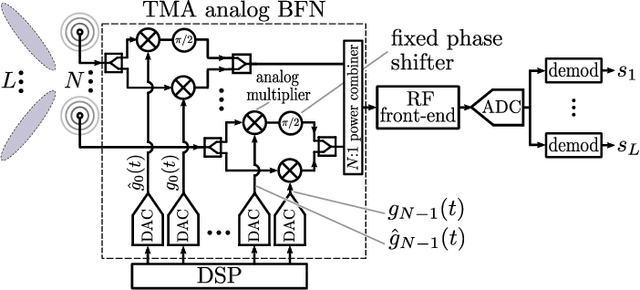
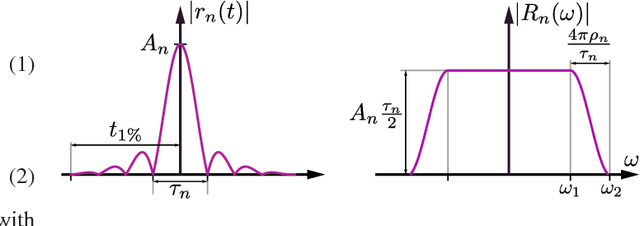
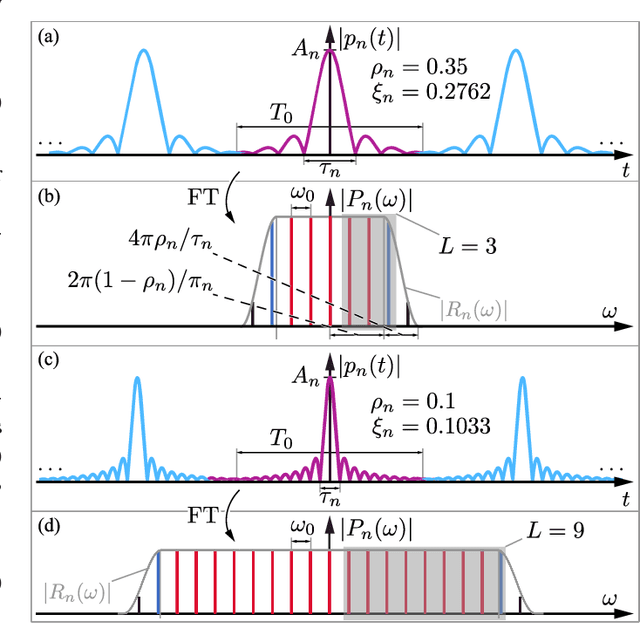
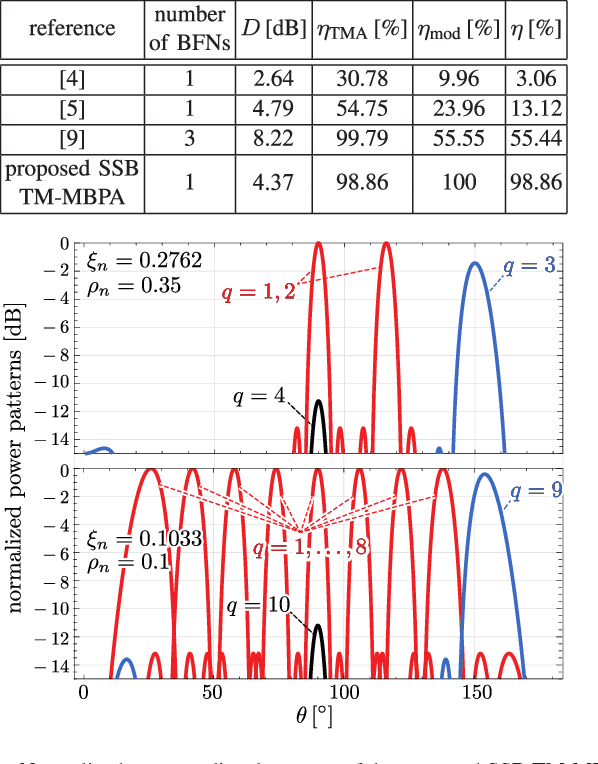
Abstract:We present a single sideband time-modulated multibeam phased array governed by periodic Nyquist pulsed signals. A Nyquist pulse is a physically realizable approach to the ideal sinc function. Hence, its low-pass spectrum suits particularly well for time-modulated arrays (TMAs) to perform harmonic beam steering. Contrarily to switched TMAs and standard solutions based on variable phase shifters, the performance and complexity of the proposed time modulation scheme is rather robust when increasing the number of multibeams.
* 4 pages, 4 figures, Published in IEEE Antennas and Wireless Propagation Letters
Time-modulated arrays with Haar wavelets
Jan 28, 2024Abstract:Time-modulated arrays (TMAs) can effectively perform beamsteering over the first positive harmonic pattern by applying progressively delayed versions of stair-step approximations of a sine waveform to the antenna excitations. In this letter, we consider synthesizing such stair-step sine approximations by means of Haar wavelets. Haar functions constitute a complete orthonormal set of rectangular waveforms, which have the ability to represent a given function with a high degree of accuracy using few constituent terms. Hence, when they are applied to the TMA synthesis, employing single-pole double-throw switches, such a feature leads to an excellent rejection level of the undesired harmonics as well as a bandwidth greater than that supported by conventional TMAs with on-off switches.
* 5 pages, 4 figures, Published in IEEE Antennas and Wireless Propagation Letters
Time-modulated phased array controlled with non-ideal bipolar squared periodic sequences
Jan 27, 2024Abstract:Bipolar (+/-1) sequences with no zero state suit particularly well for safeguarding the switched feeding network efficiency when applied to time-modulated arrays (TMAs). During the zero state of a conventional time-modulating sequence, if a given array element is switched off, a certain amount of energy of the transmitted/received signal is wasted. We propose a novel single sideband time-modulated phased array (TMPA) architecture governed by realistic bipolar squared sequences in which the rise/fall time of the switches is considered. By using single-pole dual-throw switches and non-reconfigurable passive devices, the TMPA exploits, exclusively, the first positive harmonic pattern while exhibiting an excellent performance in terms of efficiency and control level of the undesired harmonics without using synthesis optimization algorithms (software simplicity).
* 5 pages, 5 figures, published in IEEE Antennas and Wireless Propagation Letters
Bit error probability and capacity bound of OFDM systems in deterministic doubly-selective channels
Jan 27, 2024Abstract:Doubly-selective channels, such as those that occur when the transmitter and the receiver move relative to each other at high speeds, are a key scenario for fifth generation (5G) cellular systems, which are mostly based in the use of the orthogonal frequency-division multiplexing (OFDM) modulation. In this paper, we consider an OFDM system using quadrature amplitude modulation (QAM) symbols and we show that, when transmitting over deterministic doubly-selective channels, the inter-carrier interference (ICI) affecting a symbol can be well approximated by a complex-valued normal distribution. Based on this, we derive a lower bound for the link capacity using the Shannon-Hartley theorem. Finally, we provide an approximation of the bit error probability (BEP) using the well-known BEP expressions for Gray-coded QAM constellations over additive white Gaussian noise (AWGN) channels, and show numerical results that confirm that the proposed BEP expression approximates accurately the bit error ratio (BER) of the OFDM system for standardized channel models. The proposed closed-form analytical expressions for the capacity and the BEP do not only allow for discarding the need of computationally-costly Monte-Carlo system simulations, but also provide a theoretical framework to optimize the system parameters directly impacting on the achievable performance.
* 12 pages, 11 figures, published in IEEE Transactions on Vehicular Technology
Time-modulated array beamforming with periodic stair-step pulses
Jan 27, 2024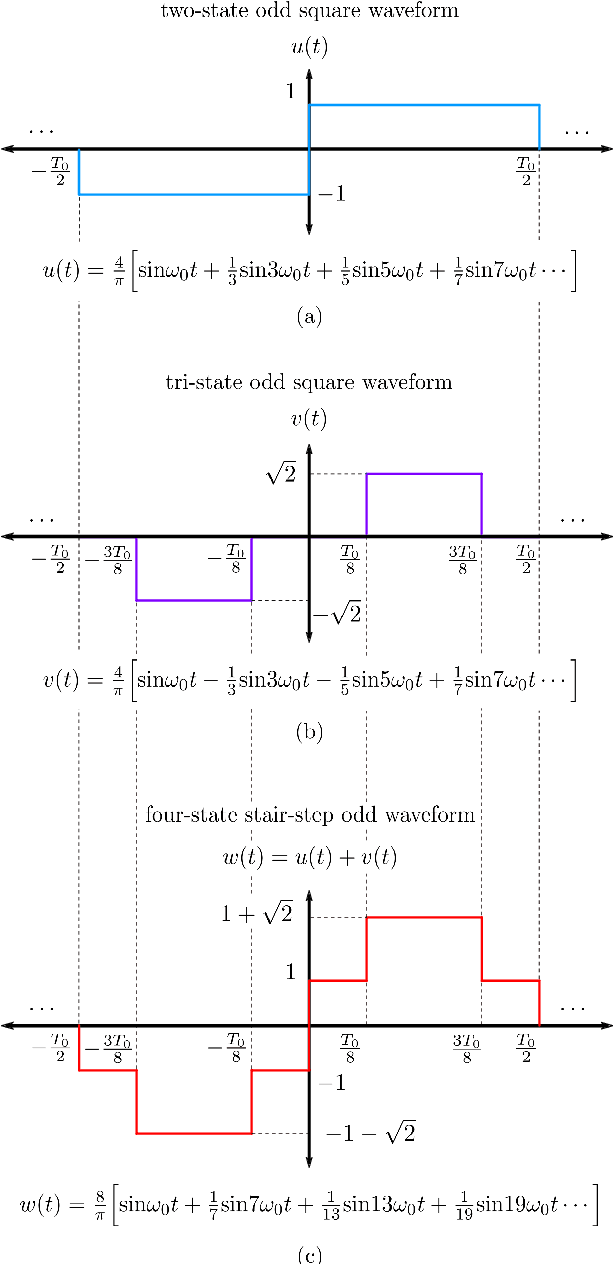
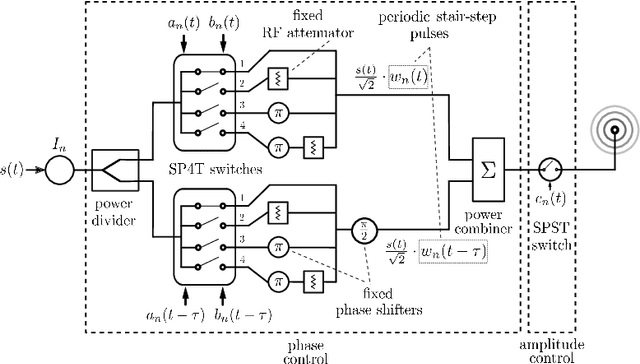
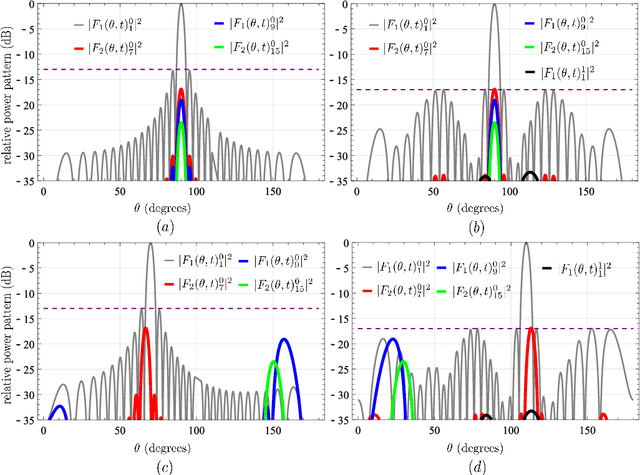

Abstract:Time-modulated arrays (TMAs) are able to improve the side-lobe level of the radiation pattern at the fundamental mode but cannot steer the beam at such a mode towards a given direction. Beam-steering is possible in a TMA, but only at the harmonic patterns and at the expense of a severe TMA efficiency reduction. In this work we propose a TMA approach that simultaneously performs both features over the same beam by using two sets of switches: (1) single-pole four-throw switches to generate periodic stair-step pulses suitable for efficiently synthesizing a uniform steerable beam over the first positive harmonic, and (2) single-pole single-throw switches to reconfigure the side-lobe level of the previous beam. Performance, small size, cost-effectiveness, and performance invariability with the carrier frequency are features that make this TMA approach a competitive solution for analog beamforming. Accordingly, the structure is an attractive proposal for the design of multibeam transceivers.
* 14 pages, 9 figures, published in Signal Processing
 Add to Chrome
Add to Chrome Add to Firefox
Add to Firefox Add to Edge
Add to Edge